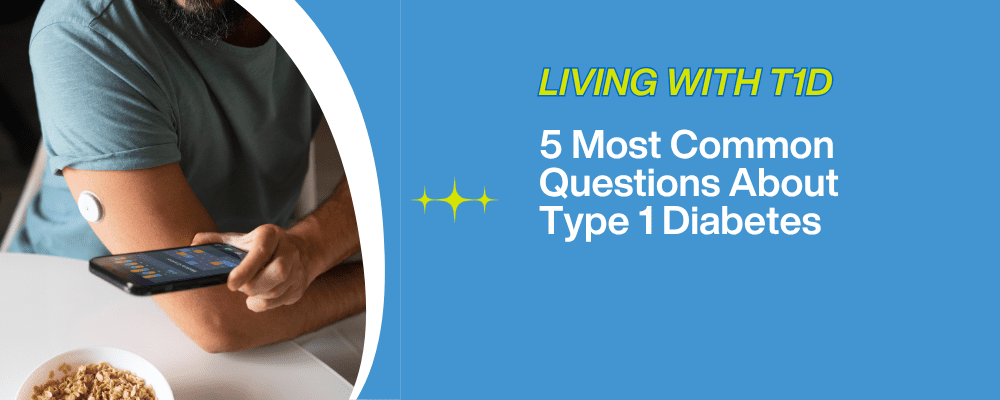Winter brings festive cheer, cozy nights, and winter sports, For individuals with Type 1 Diabetes (T1D), the cold weather can also bring challenges to blood sugar management. As the temperature drops, several factors affect insulin sensitivity, blood sugar levels, and overall diabetes control. Understanding how cold weather impacts insulin needs and taking appropriate steps to adjust management strategies is essential for staying healthy during the winter months.
Understanding Type 1 Diabetes
Type 1 diabetes (T1D) is a chronic autoimmune disease where the body’s immune system mistakenly attacks and destroys the insulin-producing cells in the pancreas. Insulin is a crucial hormone that helps regulate blood sugar levels. Without sufficient insulin, blood sugar levels can rise dangerously high, leading to various health complications.
The exact cause of T1D remains unclear, but it is believed to result from a combination of genetic predisposition and environmental triggers. Individuals with certain genetic markers may be more susceptible to developing T1D, and factors such as viral infections or other environmental influences might trigger the autoimmune response.
Symptoms of T1D can appear suddenly and may include increased thirst and urination, fatigue, blurred vision, slow-healing cuts or wounds, and tingling or numbness in the hands and feet. If left untreated, T1D can lead to severe complications like diabetic ketoacidosis (DKA), nerve damage (neuropathy), kidney damage (nephropathy), blindness (retinopathy), and cardiovascular disease.
Early diagnosis and prompt treatment are vital to managing T1D effectively and preventing these complications. Regular monitoring of blood sugar levels and appropriate insulin therapy are essential components of diabetes control.
The Effect of Cold Weather on Insulin Sensitivity
One of the primary ways winter weather affects T1D management is through changes in insulin sensitivity. When the body is exposed to cold temperatures, blood flow to the skin and extremities decreases as the body prioritizes preserving heat in the core. This reduction in circulation can slow the absorption of insulin from injection sites, such as the abdomen or thighs, making insulin less effective.
In addition to this physical response, cold weather often leads to slower metabolism. The body burns fewer calories to maintain temperature, and this can influence the rate at which insulin is processed. For some people with T1D, this could mean that they require less insulin to maintain steady blood sugar levels.
However, the effect on insulin sensitivity can vary between individuals. Some people find that they need less insulin in the winter months, while others may experience increased insulin needs, particularly during periods of physical inactivity or illness. Understanding these changes and closely monitoring insulin levels can help you make the necessary adjustments.
Blood Sugar Fluctuations in Winter
Cold weather can bring about both high and low blood sugar levels. As the body’s metabolism slows in winter, insulin sensitivity may be reduced, leading to a higher insulin resistance. This can result in elevated blood sugar levels.
Additionally, the holiday season often leads to higher carbohydrate intake, which can exacerbate these fluctuations. Utilizing continuous glucose monitoring (CGM) systems can help track blood sugar levels in real-time, providing valuable insights for better management during the winter.
On the other hand, the cold can also increase the risk of hypoglycemia (low blood glucose level). When you’re exposed to cold temperatures, your body’s blood vessels constrict in an effort to preserve warmth, and this can make it harder to detect symptoms of hypoglycemia, such as sweating, shaking, or dizziness. The cold can also cause blood sugar levels to drop more quickly if you’re outside for extended periods or engaged in winter activities like skiing, ice skating, or even shoveling snow.
Practical Tips for Managing T1D in Cold Weather
Managing T1D during winter requires extra attention to ensure that blood sugar levels remain stable, and insulin doses are correctly adjusted. Here are some practical tips to help navigate the colder months:
- Monitor Blood Sugar More Frequently: Frequent blood sugar monitoring is crucial in the winter, especially as insulin sensitivity changes. Testing your blood sugar multiple times a day, and more often if you’re participating in winter activities or traveling, will help you identify trends and adjust insulin doses accordingly.
- Dress Appropriately for Winter Activities: While it may seem unrelated, how you dress during winter activities can affect insulin absorption. Wearing multiple layers or tight clothing can interfere with the insulin injected into the skin. It’s best to wear looser clothing when planning to inject insulin to ensure it absorbs properly. Additionally, if you use an insulin pump, be mindful of where you place it during cold weather—insulin can freeze in the tubing if exposed to extreme cold, which could impact the effectiveness of your doses.
- Adjust Insulin Doses Based on Activity: Winter activities such as skiing, snowshoeing, and even walking in the snow can increase insulin sensitivity due to the physical exertion. When engaging in these activities, your body may require less insulin. Be prepared to reduce your insulin dose before and after physical activity to prevent hypoglycemia. However, it’s important to monitor your blood sugar closely and adjust your insulin as needed to avoid any sharp blood sugar fluctuations.
- Keep Insulin Safe in the Cold: Insulin must be stored at the right temperature to maintain its effectiveness. It is important to avoid leaving your insulin outside in freezing conditions for extended periods. Make sure to carry your insulin inside your coat or jacket to protect it from freezing. If you’re traveling or spending time outdoors, consider using an insulated pouch to maintain the correct temperature for your insulin.
- Stay Active Even in Cold Weather: With the colder weather and shorter days, it’s easy to become less active during winter. However, staying active helps improve insulin sensitivity and stabilizes blood sugar. If outdoor activities aren’t your preference, consider indoor exercises like yoga, swimming, or even dancing to keep your blood flowing and your insulin needs balanced.
Insulin Pump Management in Winter
Managing an insulin pump during the winter months requires special attention to ensure it functions correctly despite the cold temperatures. Here are some practical tips to help you keep your insulin pump in optimal condition:
- Keep Your Pump Close: Wear your insulin pump close to your body to maintain a stable temperature. You can tuck it under your clothing or use a pump pouch to keep it warm.
- Use Protective Covers: Invest in a pump case or cover to shield your pump from cold temperatures and moisture. This can help prevent any potential damage from exposure to the elements.
- Avoid Extreme Cold: Never leave your insulin pump in a cold car or outside in freezing weather. Extreme cold can affect the pump’s performance and the insulin’s effectiveness.
- Maintain Insulin Temperature: Keep your insulin cartridges and reservoirs at room temperature to prevent them from freezing. Frozen insulin can lose its potency, leading to poor blood sugar control.
- Consider Temperature Sensors: Some insulin pumps come with built-in temperature sensors that monitor the insulin’s temperature and alert you if it gets too cold. This feature can be particularly useful during winter.
- Waterproof Protection: If you plan to engage in outdoor activities like skiing or snowboarding, consider using a waterproof case or cover for your pump to protect it from snow and moisture.
By following these tips, you can ensure that your insulin pump functions properly throughout the winter, helping you maintain good blood sugar control.
Winter-Specific Challenges for People with T1D
Beyond blood sugar management, winter presents other challenges that can impact individuals with T1D. Shorter days and limited sunlight can lead to lower levels of vitamin D, which has been linked to insulin sensitivity. Consider incorporating foods rich in vitamin D, such as fortified dairy products, or discuss supplementation with your healthcare provider. Additionally, monitoring blood pressure regularly is crucial, as cold weather can impact cardiovascular health, especially for individuals with T1D.
Traveling during the holidays also presents unique obstacles. Changing routines, irregular meals, and varying insulin dosages can throw off diabetes management. Be sure to plan ahead, pack all necessary supplies, and adjust your schedule to maintain consistent blood sugar monitoring and insulin administration.
Embracing Winter with Confidence: Mastering T1D Management
Managing T1D during the winter months requires extra vigilance and flexibility. The cold weather can affect insulin sensitivity, increase the risk of hypoglycemia, and introduce challenges from holiday meals and reduced activity. Innovative treatments, like Replacement Beta-Cells From An Unexpected Source, offer promising solutions for better blood sugar management. By monitoring blood sugar more frequently, adjusting insulin doses, staying active, and properly storing insulin, individuals with T1D can maintain stable blood glucose levels and enjoy the season to the fullest.
As always, working closely with your healthcare provider is essential for fine-tuning your T1D management plan to ensure it accommodates the unique challenges of the colder months. With the right strategies in place, you can stay healthy and confident through the winter season.
Take charge of your winter wellness by staying proactive and informed about T1D management. Explore more expert tips and support vital T1D research by visiting Diabetes Research Connection today!




